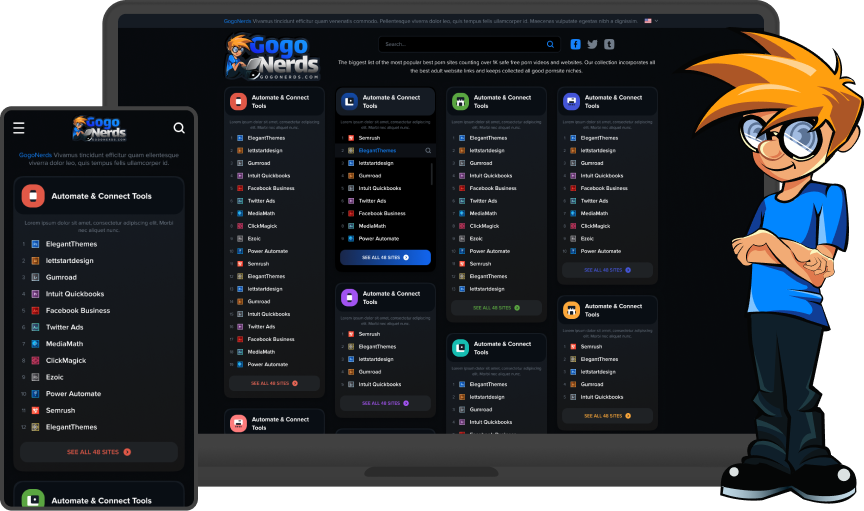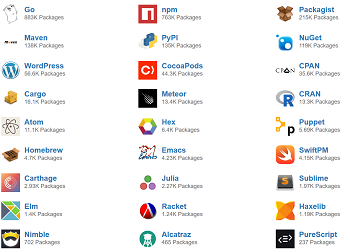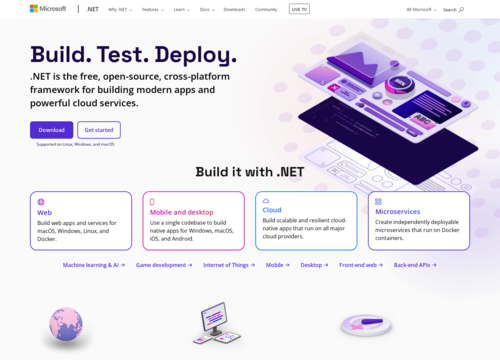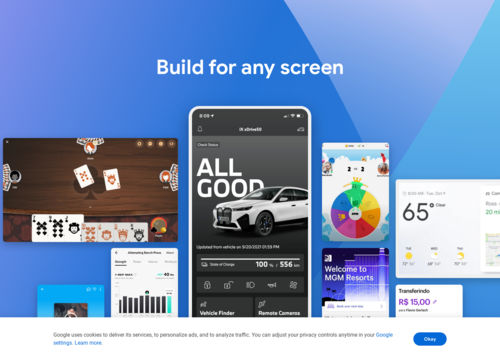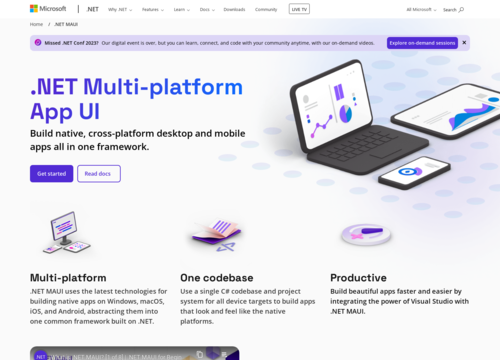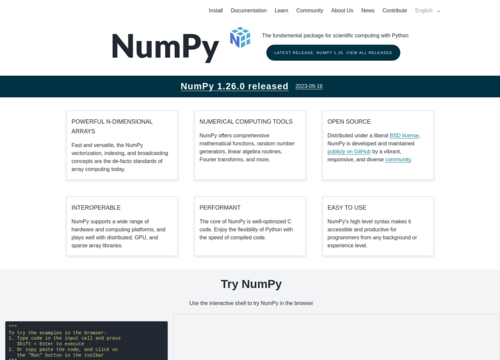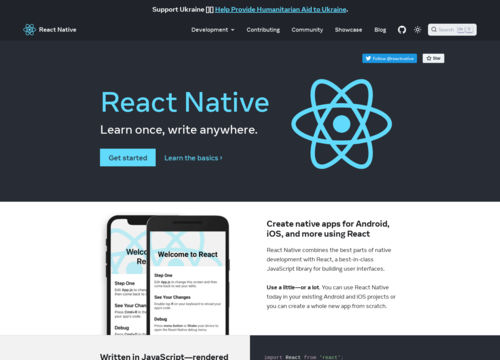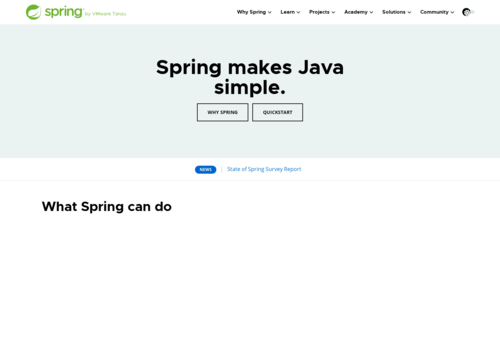.NET (dot NET)
https://dotnet.microsoft.com/en-us/.NET (dot NET)
.NET, often stylized as .NET Framework, is a software framework developed by Microsoft that primarily runs on Microsoft Windows. It's an integral part of many applications running on Windows and provides a large body of pre-coded solutions to common program requirements, known as the Framework Class Library (FCL). Let's see the key aspects of .NET:
Framework Class Library (FCL)
This is a huge library of reusable classes, interfaces, and value types that expedite and optimize the software development process. These cover a broad range of programming needs including web application development, database connectivity, data access, and networking.
Common Language Runtime (CLR)
This is the heart of the .NET Framework. It acts as an execution engine that handles running applications. It provides services like memory management, security enforcement, exception handling, and more. One of the key features of CLR is its ability to allow programmers to write in multiple programming languages. This is because it provides a common runtime environment for all .NET languages.
Programming Languages:
.NET supports a variety of programming languages, allowing developers to choose the one that best suits their needs or preferences. The most notable languages supported in the .NET framework are:
C# (C Sharp)
C# is the most popular language for .NET development. It's a modern, object-oriented programming language developed by Microsoft. C# is versatile and powerful, making it suitable for a wide range of applications including web, mobile, desktop, and cloud-based applications.
Visual Basic .NET (VB.NET)
VB.NET is an object-oriented language that is simple and easy to learn, especially for those familiar with the earlier versions of Visual Basic. While it shares the same runtime as C#, its syntax is simpler and less terse, which can be beneficial for new programmers.
F#
F# is a functional-first programming language that also supports object-oriented and imperative programming. It's known for its concise syntax and is particularly well-suited for scientific and data-heavy applications.
ASP.NET
While technically not a language but a framework, ASP.NET is significant in the .NET ecosystem. It supports multiple languages like C# and VB.NET for building web applications. It offers a powerful, patterns-based way to build dynamic websites, enabling a clean separation of concerns and giving you full control over markup.
C++/CL
(C++ Modified for Common Language Infrastructure): C++/CLI is a version of C++ that includes extensions for the Common Language Infrastructure. It is used for mixed-mode programming, which allows combining native C++ code with managed .NET code.
In addition to these primary languages, .NET also supports interoperability with many other languages. This feature allows applications written in different languages to communicate with each other. Languages like Python, Ruby, and Perl can interact with .NET libraries through various means, although they are not natively supported in the .NET framework.
Language Interoperability
One of the most notable features of .NET is its language interoperability. It allows code written in one language to use code and libraries from another language. Popular languages that can be used in .NET include C#, VB.NET, and F#.
Base Class Library (BCL)
This is a subset of the FCL and provides the most fundamental classes that are common to all .NET languages. This includes basic types like strings and numbers, collections, file I/O, threading, and more.
ASP.NET
This is a significant part of the .NET Framework aimed at web development. It allows for the creation of dynamic web pages, web applications, and web services. ASP.NET comes with a rich toolbox and designer in the Visual Studio integrated development environment, offering a robust infrastructure for building scalable, high-performance web applications.
Entity Framework
This is an open-source object-relational mapping framework for ADO.NET, which is part of the .NET Framework. It simplifies the data access layer of applications by allowing developers to work with data in the form of domain-specific objects, without having to deal with the underlying database tables and columns where this data is stored.
Windows Presentation Foundation (WPF)
For building rich client applications, WPF is part of .NET. It uses XAML (an XML-based language) to create a separation between the interface (UI) and the business logic. This makes the development process more manageable and streamlined.
Universal Windows Platform (UWP)
This is for building modern applications that can run on Windows 10 devices including PCs, tablets, phones, and more. It emphasizes a unified app experience across all these devices.
.NET Core and .NET 5 and beyond
.NET Core is a cross-platform, open-source re-implementation of the .NET Framework. It's designed to have a modular architecture so that applications require only the necessary components of the framework. With the introduction of .NET 5 and later versions, Microsoft aims to unify the .NET ecosystem, integrating the best of .NET Core, .NET Framework, Xamarin, and Mono into one platform.
Cross-Platform and Open Source
With the advent of .NET Core and its evolution into .NET 5 and later versions, .NET has truly embraced cross-platform capabilities. This means developers can build applications that run on Windows, Linux, and macOS. Moreover, being open-source, it has a vibrant community contributing to its development and evolution.
Microservices Architecture
.NET supports the development of microservices – small, modular, and independently deployable services. This architectural style is particularly beneficial in building scalable and complex applications. ASP.NET Core is widely used for creating microservices due to its lightweight, high performance, and scalability.
Cloud Support
.NET is cloud-ready and integrates seamlessly with cloud services, especially with Microsoft Azure. This allows developers to build, deploy, and manage .NET applications directly in the cloud, taking advantage of Azure’s robust features like AI, machine learning, and IoT services.
Machine Learning and AI
With ML.NET, a machine learning framework for .NET developers, it's possible to implement machine learning in .NET applications. This adds a layer of advanced analytics and predictive functionality to apps, making them more dynamic and intelligent.
High Performance
One of the primary focuses of the recent versions of .NET has been performance. With each release, there are significant improvements in speed and efficiency, making .NET one of the fastest frameworks for building web applications.
Robust Security Features
.NET has always been recognized for its robust security mechanisms. It provides features like code access security, validation and verification, encryption, and secure communication tools to ensure the safety and security of applications.
Integrated Development Environment (IDE)
Microsoft provides Visual Studio, an IDE extensively used for .NET development. Visual Studio offers powerful features like debugging, code repository management, a rich set of libraries and extensions, and an intuitive user interface, which greatly enhance the developer experience.
Community and Ecosystem
.NET benefits from a large and active community of developers. There's extensive documentation, active forums, third-party tools, libraries, and frameworks that continuously enrich the .NET ecosystem.
Compatibility and Migration
With the newer versions of .NET, there's a strong emphasis on backward compatibility, making it easier for businesses to migrate their legacy .NET applications to the latest versions without significant rewrites.
Rich Set of Libraries and APIs
.NET provides an extensive set of libraries and APIs that cover almost every aspect of application development, from graphical interfaces to data access, and from network communications to cryptography.
Education and Resources
Microsoft and the developer community provide a wealth of learning resources, including tutorials, documentation, online courses, and community-driven content, making it easier for new developers to learn and master .NET.
.NET is a mature, versatile, and continuously evolving framework that caters to a wide range of development needs. Its robustness, scalability, and the support of a massive ecosystem make it a preferred choice for developers and enterprises worldwide. Whether for building small desktop applications or complex enterprise-level solutions, .NET provides the necessary tools and features to bring ideas to life efficiently and effectively.

More Categories
Back To Home